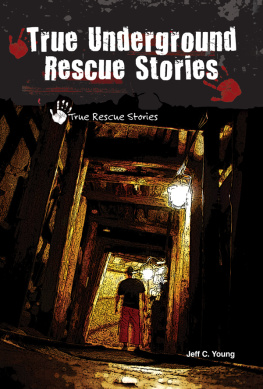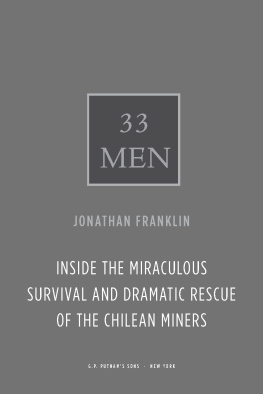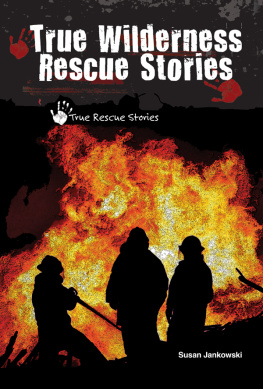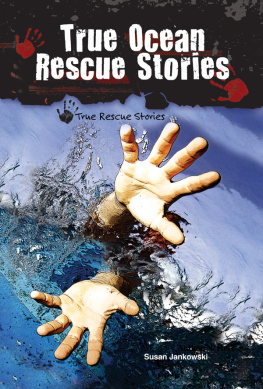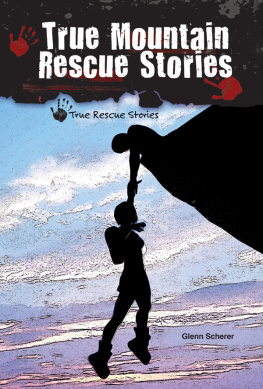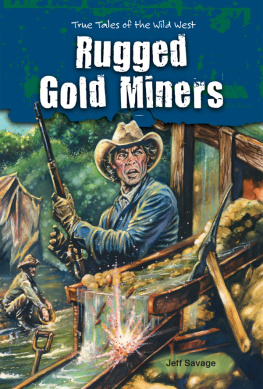UNDERGROUND AND UNSAFE
A baby trapped in a well, a man looking for caves in Kentucky, coal miners and gold miners put in deadly predicaments, and a man rescuing another from an oncoming subway train. What do these stories have in common? They are all dramatic accounts of rescue missions that took place below the surface of the earth. These true stories will add intrigue as you find out what it means to sacrifice for others for the betterment of all.
About the Author
Award-winning author Jeff C. Young has also worked as a library media specialist, reference librarian, and as a sportswriter for several Florida newspapers. When he is not watching sports or writing, he enjoys reading, bicycling, basketball, and tossing a Frisbee
The well that Baby Jessica fell in was 120-feet deep. Fortunately, she only fell about 22 feet before being wedged between rocks.
Jessica McClures rescue was front-page news in more than just the United States. It was also the lead story in Japan and many European countries.
Midland, Texas, was home to McClure, as well as many other famous people. Among them are actors Woody Harrelson, Tommy Lee Jones, and Kathy Baker.
Floyd Collins was an experienced caver by the time he was a teenager.
Sand Cave, where Collins was trapped, is now part of Mammoth Cave National Park in Kentucky.
The National Guard had to be called in to maintain order once Collins was trapped and his attempted rescue became a media frenzy.
The Quecreek Mine was located in Lincoln Township, part of Somerset County in southeastern Pennsylvania.
Rescue crews used a GPS (global positioning system) to figure out the exact location of the trapped Quecreek miners. Many people think of a GPS as something they have in their cars or as a feature on their cell phones, but GPS systems are also a fantastic tool for search and rescue teams.
Despite the risks of coal mining, the United States continues to mine more coal than any country other than China.
The Elandsrand Mine is also known as the Elandskraal Mine.
According to a press release from the Harmony Gold Mining Company, forty-eight days of production were lost due to the mining disaster.
Fortunately, all 3,200 miners trapped at Elandsrand survived the accident.
Wesley Autrey was enjoying time off of his construction job with his two daughters when he was thrust into the spotlight after saving the life of Cameron Hollopeter.
Autrey was given a standing ovation after being singled out as an example of a courageous American by President George W. Bush during Bushs 2007 State of the Union Address.
According to the New York Transit Museum, as of 2010 the New York subway system serves nearly 5 million riders per day.
Jessica McClure was a curious eighteen-month-old toddler with a near fatal attraction to an abandoned well. Her curiosity caused her to get trapped inside the well for over fifty-eight hours while the world anxiously watched a crew of dedicated rescuers attempt to free her.
On the morning of October 14, 1987, Jessica was playing with some other children in the backyard of her aunts Midland, Texas home. While Jessica was playing, the other children removed a potted plant that had been covering the top of the well. Jessica wanted to take a closer look and see what the plant had been hiding underneath it. She sat herself down on the edge of the well and dangled her feet inside the narrow opening.
When she tried to stand up, Jessica lost her balance and fell inside. The well was 120-feet deep, but Jessica only fell around 22 feet before getting wedged inside. Her left leg dangled beneath her while her right leg got pinned up close to her chest. Jessicas forehead was stuck against the side of the well. While it was a very uncomfortable position, it kept Jessica from falling any farther.
Its not known how long it took for someone to notice her absence. But, in a short time, a crew of rescuers and citizen volunteers were feverishly working to free her. They started digging a shaft next to the well where she was trapped. A layer of extremely hard rock hampered the rescue effort.
I dont think that Ive ever drilled through anything harder than that, recalled driller Charles Boler. You could hear her crying as we got closer. Thats what kept me going because I had a two-year-old child at the time and I could identify with the family.
By using a water jet cutter to help them bore through the dense rock, the rescuers drilled a vertical shaft parallel to the well. Then they had to go through more solid rock to bore a five-foot-long horizontal tunnel to reach Jessica. The dense caliche, or hardpan rock, they bored through blunted the power of the diamond-tipped bits on their pneumatic drills.
The rescuers monitored Jessica by lowering a microphone into the well. They could hear Jessica alternately crying for her mother, humming, and singing. Jessica comforted herself by singing Jesus Loves Me and the Winnie-the-Pooh song. One rescuer said, I made her mad. Ive been telling her for the last twenty hours that we were coming down to get her out. I dont think she believes me.
Heat was blown into the hole to keep Jessica from shivering. She stayed warm, but she had to go without food and water while she was trapped. Doctors were worried that liquids and food could worsen any internal injuries that she may have sustained. Another concern was that trying to eat in such a tight space would cause her to choke.
A horde of reporters, photographers, cameramen, and news outlets descended upon the rescue site. They brought news of Jessicas ordeal to millions of people throughout the world. In America, Jessicas entrap-ment and rescue overshadowed other major news stories like a stock market crash and First Lady Nancy Reagan undergoing cancer surgery. In Europe, German and British television stations carried live coverage of the rescue. In Japan, the rescue of Jessica was a front-page story in their major newspapers.
On Friday, October 16, Jessica was rescued. Television cameras showed a barefoot, dirty, and bruised little girl being raised from the well. Jessicas right hand was stuck to her face and her head was bandaged. She was strapped to a board. Scott Shaw, a photographer for the Odessa American, won a Pulitzer Prize for his photo of Jessicas rescue. CBS anchorman Dan Rather proclaimed, Live and direct from Midland, Texas. Jessica McClure is up. Shes alive. What a fighter.
Jessica was rushed to the Midland Memorial Hospital. She was dehydrated and her weight was down from twenty-one pounds to seventeen-and-a-half. There were no broken bones or internal injuries. Yet a lack blood circulating to one foot and to her forehead caused some complications. Jessica had one toe amputated and had to undergo repeated skin grafting operations and other surgeries that left many scars. She was in the hospital for over a month and in that time had six surgeries.
There were concerns that Jessica would also suffer permanent psychological damage. But it seems she was too young to develop any vivid or lasting memories of her ordeal. She doesnt suffer from claustrophobia, as some experts had predicted.
Twenty years after her rescue, Jessica told NBC news that falling down a well couldnt cage me then, why should it cage me now?
For a brief time after her rescue, Jessica was a celebrity. Former Midland residents Vice President George H. W. Bush and his wife, Barbara, visited Jessica when she was hospitalized. President Ronald Reagan called her. Jessica got to throw out the first pitch at a Texas Rangers baseball game. Anonymous donors paid for her medical care and additional money was put in trust fund that she will receive when shes twenty-five years old. Her rescue also became the subject of a 1989 TV movie,

